When it comes to starting a flower farm business, one of the most common questions I get from aspiring flower farmers is: Where do I start?!
Um, right?! I totally get it, I had the same question myself. While your needs will be unique to your situation, I’m discussing my 9 Must Haves for starting a flower farm business. And while I’ll get into some of the dirty details for each Must-Have item, it will become abundantly clear that each of these are their own complex topic. These will lay the groundwork and set the foundation for further deep dive posts and tools.

Note: There are a lot of source links in this post. These are because I like to actually know what folks use, like the exact thing. I don’t just want to know that you use buckets, I want to see the exact bucket (and then see if I can find it for a cheaper price, LOL). That said, I want to be transparent that some are affiliates, while others are not. I only partner with folks I truly love. These links are at NO cost to you, and instead, there are discounts and coupon codes associated with them: win-win! Any compensation goes back into creating content for this website and/or the farm (and is sincerely appreciated). You can read more about our affiliate policy here.
In this post, we’ll discuss 9 Must-Haves for a Flower Farm Business:
- Flowers (don’t laugh, this is one of the most-complex pieces of the puzzle)
- Customers/Sales Outlet
- A Legitimate Business (Choosing a Business Structure)
- Business Compliance
- Separate and Tracked Finances
- Weed Management
- Irrigation
- Harvest, Storage, & Packing Supplies
- Newsletter, Website (and Probably Social Media)
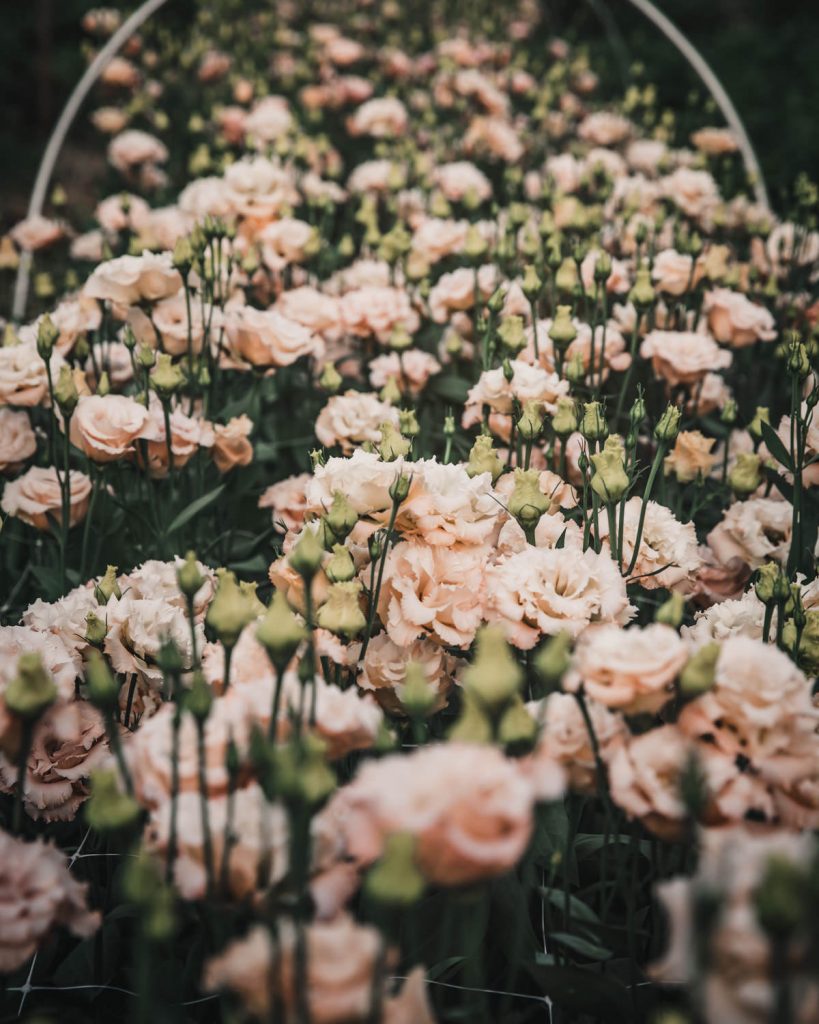
1. Flowers!
While this might sound obvious, the devil is in the details. In order to actually have a flower farm, yes you need flowers, but which flowers? And how do you grow them?!
When it comes to how to grow flowers, we’ll leave that to the Plant Profiles, Tools, and Posts. When it comes to determining which flowers you will grow, there are 4 things you must consider: Business Model, Climate, Seasonality, Budget/Time.
Business Model
Before you can determine what to grow, you should determine your business model and goals. Will you specialize in growing one crop and only sell while in season (like peonies), or will you grow a variety of crops to sell throughout the season? This may change over the life of your farm, but you have to start somewhere. See Customers/Sales Outlet below for further defining your business model.

Climate
It’s important to understand your climate in order to choose flowers that will grow well. If you’re just starting out, it can be challenging to know this, but you’ll get better as you go and I’ll provide as much information as I can to make the process easier. Being a good grower is all about understanding your environment and determining if/how you can re-create optimum conditions based on each variety’s needs.
While Plant Profiles dive deep on specifics, two key items when it comes to growing great plants are knowing your Hardiness Zone and First/Last Frost Dates. If you’re located in the U.S., you can find this information here. If you’re in another country, most countries have similar hardiness zoning and maps. Simply google “[your country] + hardiness zone.”
Hardiness Zones (or Planting Zones), though useful, are only based on the average annual minimum winter temperature. The U.S., for example, is divided into into eleven 10-degree zones by minimum average annual temperatures. Each zone is also divided into “a” and “b” segments. These represent five degrees of temperature difference.
In plain English, your zone number simply refers to how cold your winters get. The lower the number is, the lower the temperatures in that zone. Where I live in Mindoro, WI, we are Zone 4b, meaning our average minimum temperatures are -25°F to -20°F (yup, it can get freakin’ cold).
When a plant is rated for a particular zone, it’s referring to how well that plant will survive cold temperatures. This is particularly useful when planting perennials.
Knowing your first and last frost dates will help you determine your growing season and making decisions when it comes to growing certain flowers. For example, some flowers can not only handle cool temperatures, they prefer it (like ranunculus)! While others are extremely frost sensitive, like zinnias.

Seasonality
If you plan on growing a variety of flowers throughout the season, it’s crucial to understand the seasonality of flowers. If you only plan on specializing on one crop, it’s still important to understand when that crop is in season, so you know when you can market and sell it. Your climate and unique geographic location will also impact this. For example, dahlias are incredibly-beautiful cut flowers that are super productive, but our season is not long enough to have dahlias in spring. Similarly, tulips are not blooming in fall.
Seasonality: Focals
If I was just starting out and wanted to grow a variety of flowers throughout the season, but did not know where to start, I would focus on focal flowers. The reason being is that you can sell them as straight bunches, and they usually are higher-price stems. Here is what I would focus on by season:
- Early Spring: Tulips
- Late Spring: Ranunculus
- Late Spring/Early Summer: Peonies & Lisianthus (peonies may take up to 3 years to be harvestable, but they are an excellent focal flower in the lull between late spring and early summer and fetch high prices)
- Early Summer: Lisianthus & Sunflowers
- Summer: Lisianthus & Sunflowers
- Late Summer: Dahlias & Sunflowers
- Fall: Dahlias & Sunflowers
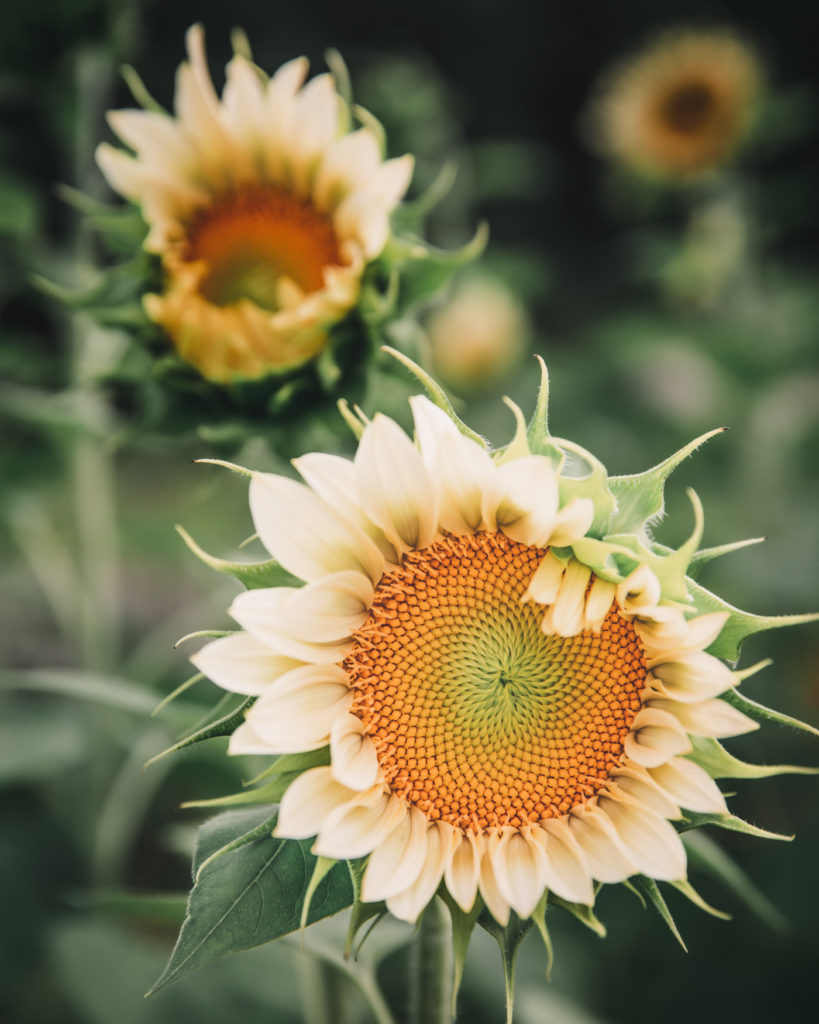
Seasonality: Design Elements
If you’re ready to take on more, you should consider different design elements and their seasonality. If you’ve ever taken a flower farm course or floral design class, you’ve likely learned that a classic combination of ingredients include elements in the following categories: Focal, Spike, Disk, Filler, Sparkly/Airy. I like to add an additional category of Whimsy (basically, unexpected elements).
My goal is to have elements in each of these categories for the entire season. Here are some of my favorites:
- SPRING
- Focals: Tulip, Peony, Ranunculus, Rose, Large Iceland Poppies
- Spikes: Snapdragons, Stock, Larkspur
- Disks: Anemone, Calendula, Narcissus, Small Iceland Poppies, Snowball Viburnum, Sweet William
- Filler: Raspberry Greens, Ferns, Willow Branches, Lilac, Bells of Ireland, Orlaya, Queen Anne’s Lace
- Airy/Sparkly: Sweet Peas, Bachelor’s Button, Chinese Forget-Me-Not, Saponaria, Agrostema
- Whimsy: Apple Tree Branches with Blossoms, Snow Peas
- SUMMER
- Focals: Rose, Sunflowers, Lisianthus, Dahlias, Zinnias
- Spikes: Snapdragons, Celosia, Russian Statice, White Mignonette,
- Disks: Ageratum, Cosmos, Phlox, Strawflower, Yarrow, Zinnia
- Filler: Basil, Ninebark, Scented Geranium, Yarrow, Feverfew, Love-in-a-Puff Vine, Statice, Amaranth, Chocolate Lace Flower, Gypsophilla, Mint, Oregano
- Airy/Sparkly: Nicotania, Grasses, Scabiosa, Craspedia, Jewels of Opar, Flax, Globe Amaranth, Thistle
- Whimsy: Cherry tomatoes, Peppers, Crabapple Branches, Asparagus Fronds, Small Summer Squash
- FALL
- Focals: Rose, Sunflowers, Lisianthus, Dahlias, Zinnias
- Spikes: Celosia, Millet
- Disks: Ageratum, Cosmos, Phlox, Strawflower, Yarrow, Zinnia
- Filler: Basil, Eucalyptus, Scented Geranium, Ninebark, Feverfew, Love-in-a-Puff Vine, Statice, Strawflower, Amaranth, Chocolate Lace Flower, Hydrangea, Gypsophilla, Mint, Oregano
- Airy/Sparkly: Nicotania, Grasses, Scabiosa, Craspedia, Jewels of Opar, Flax, Globe Amaranth, Grains, Thistle
- Whimsy: Cherry tomatoes, Peppers, Small Pumpkins
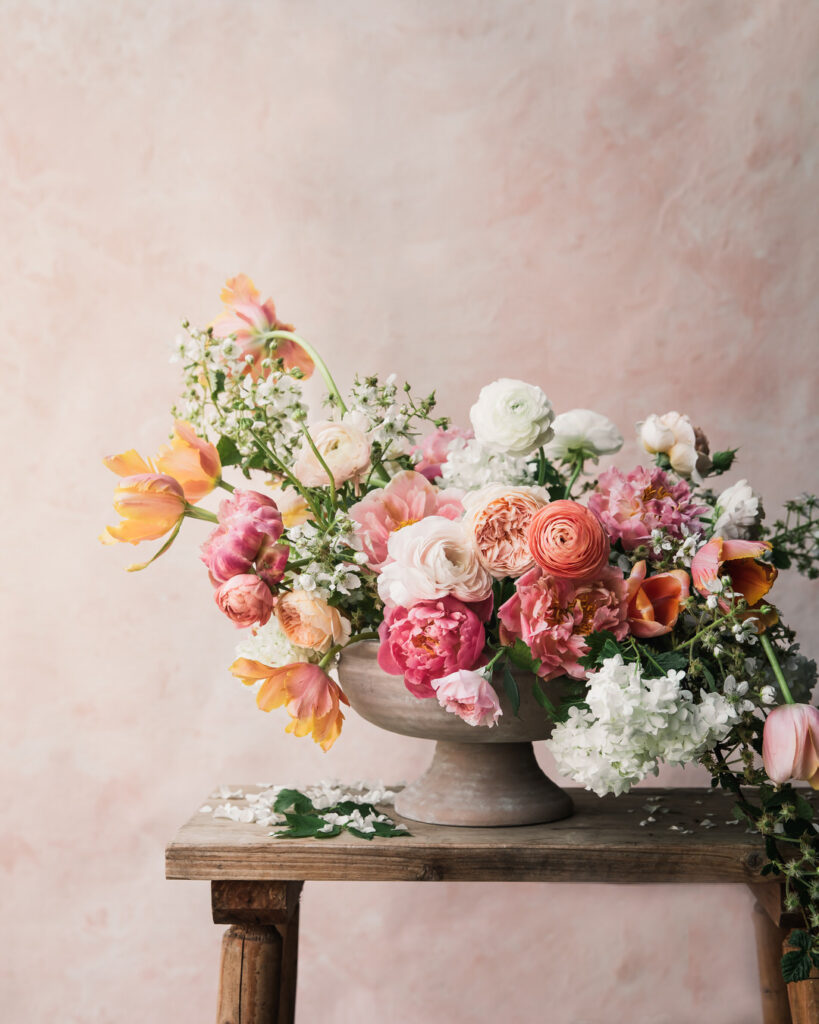
Budget and Time
Certain plants are more of an investment: whether in time, money, or both! Most annuals can be grown from seed, which tend to be more cost-effective and are ready in their first year.
Plants produced from bulbs, tubers, or corms are generally more-expensive than seeds, but produce some of the most beautiful flowers. In the northern hemisphere, bulbs are typically planted in fall and bloom in spring, corms are planted either in the fall or early spring and bloom in spring to early summer (also possible to do a fall crop in some climates). Tubers are typically planted in spring for a summer crop through to first killing frost.
Perennials, on the other hand, are one of the largest investments in time AND money. Most are grown from bare roots, cuttings, or small plants, which usually cost significantly more than seeds, bulbs, or tubers (though some rare dahlia tubers are comparable!). Some perennials can be grown from seed, but they take a much longer time to reach maturity. Even bare roots and small plants may not be ready to harvest their first year. For example, peonies (which I love) take about 3 years to establish before you can harvest them (and they are a significant investment).
If you have the capital to invest in perennials from the start, most flower farms recommend it, because these are usually a great return on your investment. Peonies, for example, are planted once and harvestable for many years. They also bloom during the lull between spring and summer flowers and can be stored for weeks. However, if your budget and/or time is limited on how soon you want to make money, annuals are a great way to go!
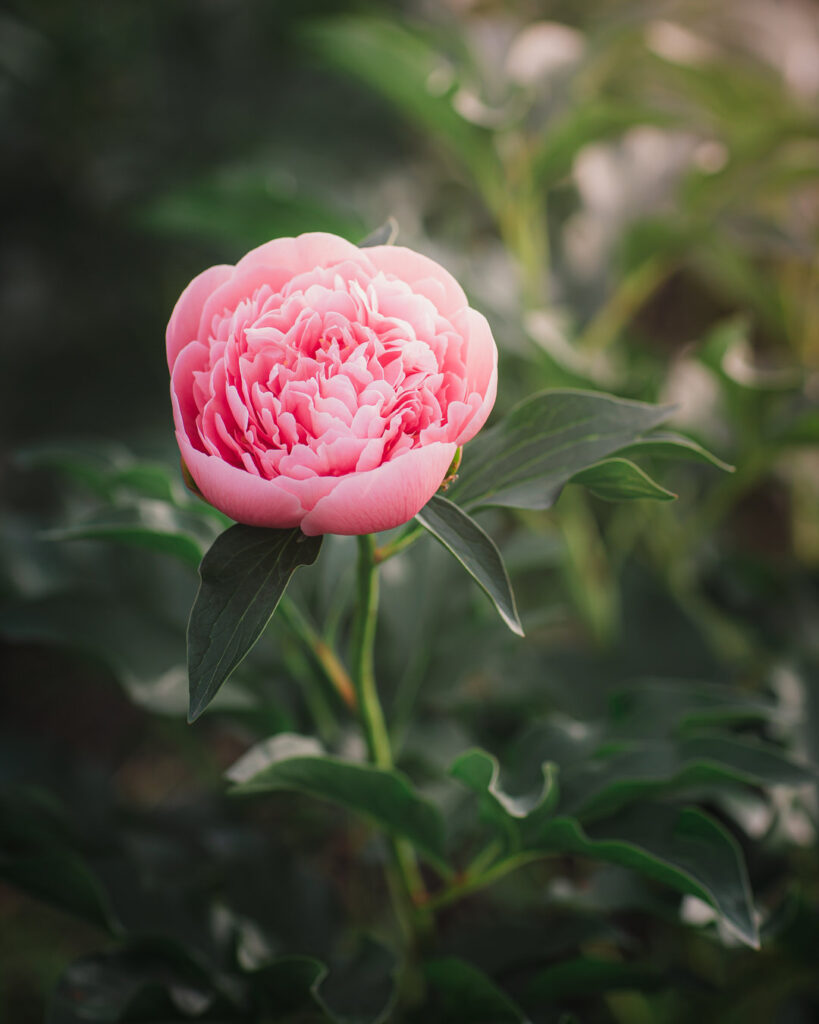
2. Customers/Sales Outlet
In order to have a flower farm business, you must have customers! For me, one of the most-appealing thing about cut flowers is that there are so many options for sales outlets. Knowing which is right for you when just starting out can feel overwhelming, but considering each option in conjunction with your market, personality, and goals can help ease the process. Here are some of the most common options to consider:
- CSA
- Farmers Market
- Farm Stand
- Grocery
- Florist
- Wedding & Events
- Wholesale
- Retail: Brick and Mortar
- Retail: Online Sales
Your sales outlets and customer base will also be a determining factor in what you grow. For example, conventional wisdom usually says to choose rich vibrant colors for grocery/markets, textural ingredients and unique combos for urban environments, and pastels and monochrome for weddings and high-end markets. Of course, rules are meant to be broken, and your unique market may have different needs. We’ll dive deep on each sales outlet in a future post.
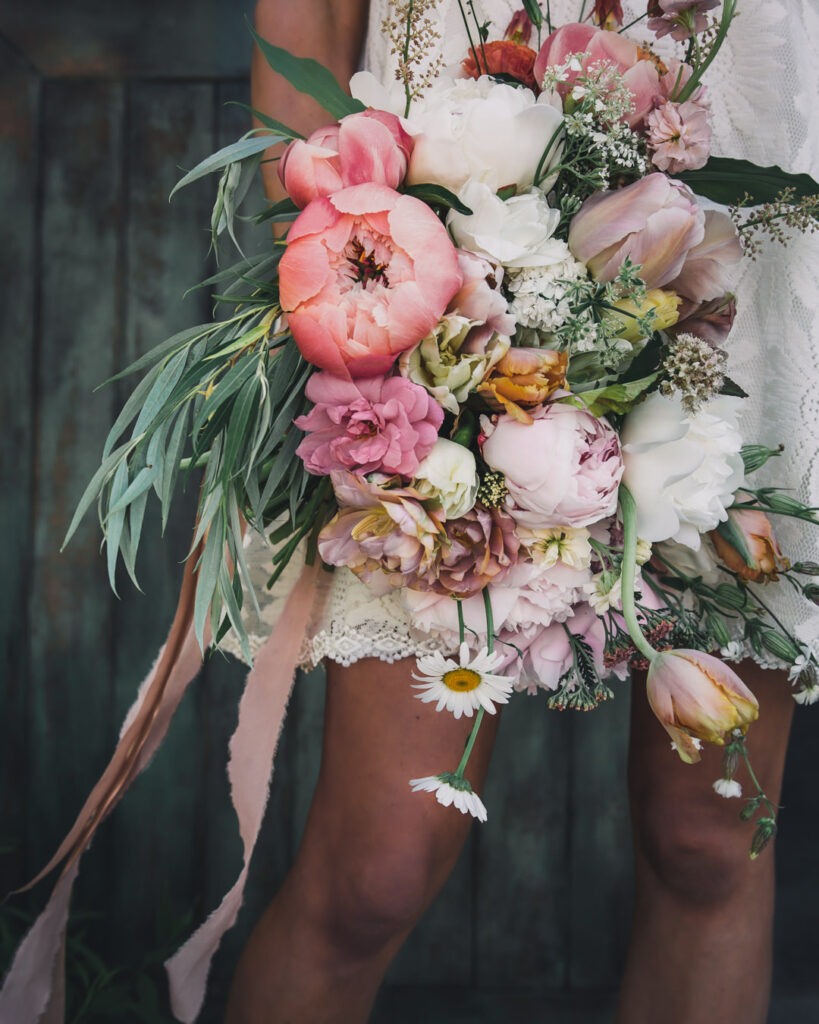
3. A Legitimate Business (Choosing a Business Structure)
Someone once told me that when you take the first step in legitimizing your business, it magnifies your momentum forward, propelling you toward new opportunities and doors will open. I have personally found this to be true!
Please note that what I share here is from what I’ve learned through my own business in the U.S. I am not a lawyer, MBA, or tax professional. This is just a fellow grower and business owner sharing her personal experience. I share this information because I wish someone would have shared it with me, but it should not be considered personal business advice.
If you are or intend to make money from what you grow, you want your business set up properly from the start. In order to have a business, you need to determine and set up your business structure.
In the U.S., most new businesses start out as sole proprietors/partnerships, because they’re super easy to set up. However, there is no distinction between your business assets and your personal assets. If your business was to run into legal/money trouble, your personal assets could also be on the line.
As businesses grow, they’ll usually form a new type of business entity, like a Corporation or Limited Liability Company (LLC), to separate their personal assets from their business assets.
Always get business and tax advice from a professional (again, I know), but here is a little breakdown:
- Sole Proprietorship and Independent Contractors: Sole proprietors and independent contractors are self-employed people who haven’t set up formal business entities and who are not classified as employees. They file business taxes using a Schedule C and have to pay self-employment taxes.
- The difference between the two is how they earn income:
- Independent contractors do specific tasks for clients for a set fee
- Sole proprietors may do contract work, but may also have other revenue streams, like selling their own products to customers
- Great option for businesses just starting out, especially if what you are doing is a hobby that you are making a little income from. No distinction between personal assets and business assets.
- The difference between the two is how they earn income:
- Corporation and Limited Liability Company (LLC): While there are more steps, requirements, and fees for setting up a Corporation or LLC, both protect company owners from personal liability for business obligations
- Corporations are owned by “shareholders” while LLCs are owned by “member(s)” (either a single member or multi member)
- By default, Corporations are taxed as a C corp
- Single-member LLCs are automatically taxed like sole proprietorships and multi-member LLCs are automatically taxed like partnerships. However, an LLC can also elect to be taxed as a C corp or, if it qualifies, an S corp (these all have different filing and tax requirements).
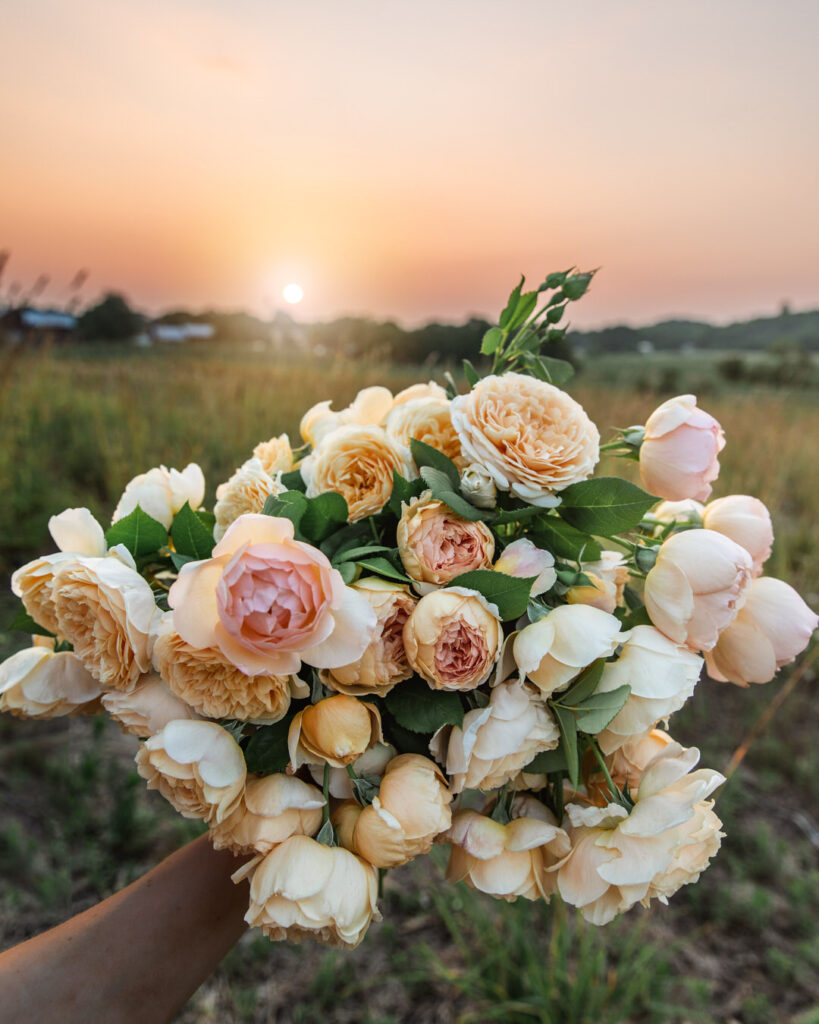
4. Business Requirements and Compliance
If you’re selling flowers, you want to make sure you’re in compliance with the law. The requirements for running your business will depend on where you’re located. In the U.S., for example, each state, city, and even county have different requirements. Look up your local taxing authority, and research the requirements to operate your business. Most have really helpful resources that you can read online or offer additional support if needed.
You want to look into things like: do you need a license or permit to sell flowers? If you plan to create wholesale accounts to take advantage of better pricing/nontaxable purchases, what’s required? In the U.S., you usually need a resale certificate to set up wholesale accounts. Are you obligated to collect sales tax? If so, how do you register to collect sales tax and how much do you need to collect? And what the heck do you do with it after you collect it? (Answer: in the U.S., you need to remit it to the state in which you collected it).
In my home state of Wisconsin, we refer to the Wisconsin Department of Revenue to research county, city, state, and federal requirements for our small business. Our business is registered and we have an Employer Identification Number (EIN), also known as the Federal Employer Identification Number or the Federal Tax Identification Number. For wholesale purchases, we have a resale certificate (obtained from the DOR website). In Wisconsin, we are required to remit both state sales tax (5%) and county sales tax (if the county has a sales tax, usually 0.5%). In order to collect sales tax, we had to register for and obtain a seller’s permit. For every purchase, we collect and remit sales tax (again, this is all done through the DOR website).
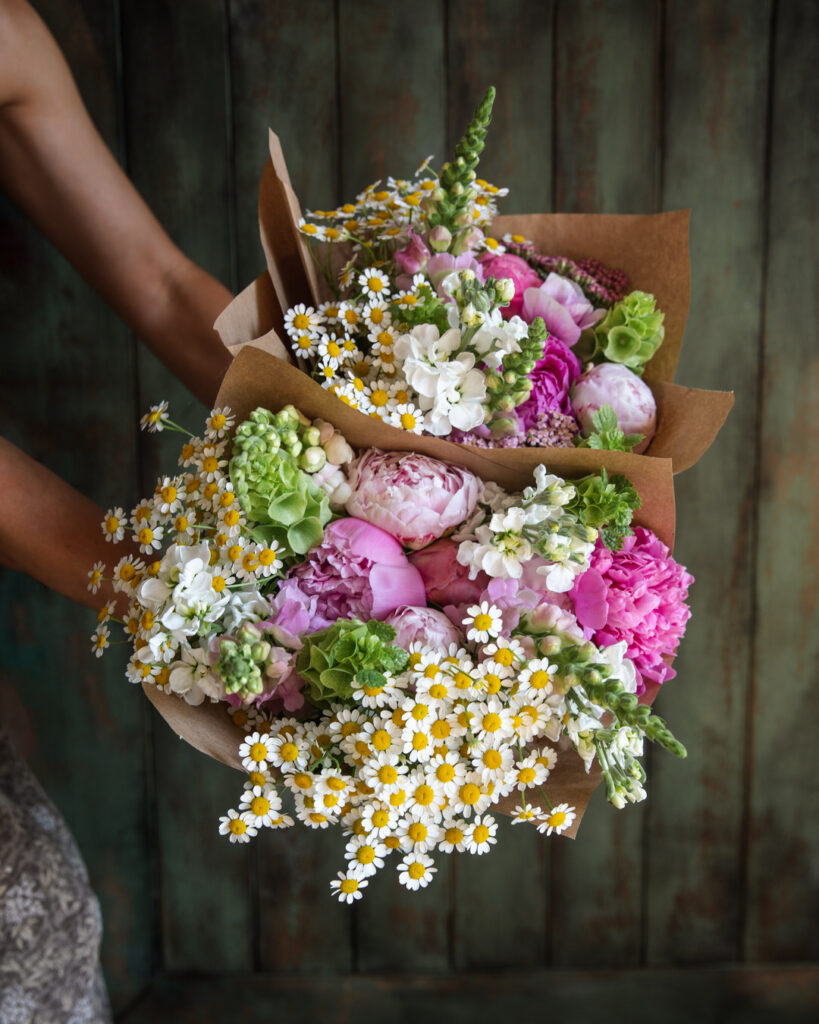
5. Separate and Tracked Finances
Separating personal and business finances is a must when it comes to running a business. Mixing finances can convolute and overcomplicate things, and there are also potential liability issues with doing so. If you’re just starting out, I’d recommend a separate business bank account for income and a separate business card for purchases. Keeping these separate makes things much easier come tax season.
As far as tracking finances, there are many different methods. You can keep it simple with a spreadsheet or use programs like Quickbooks. I like the Profit First method, but the method is less important that simply getting into the habit of doing it.
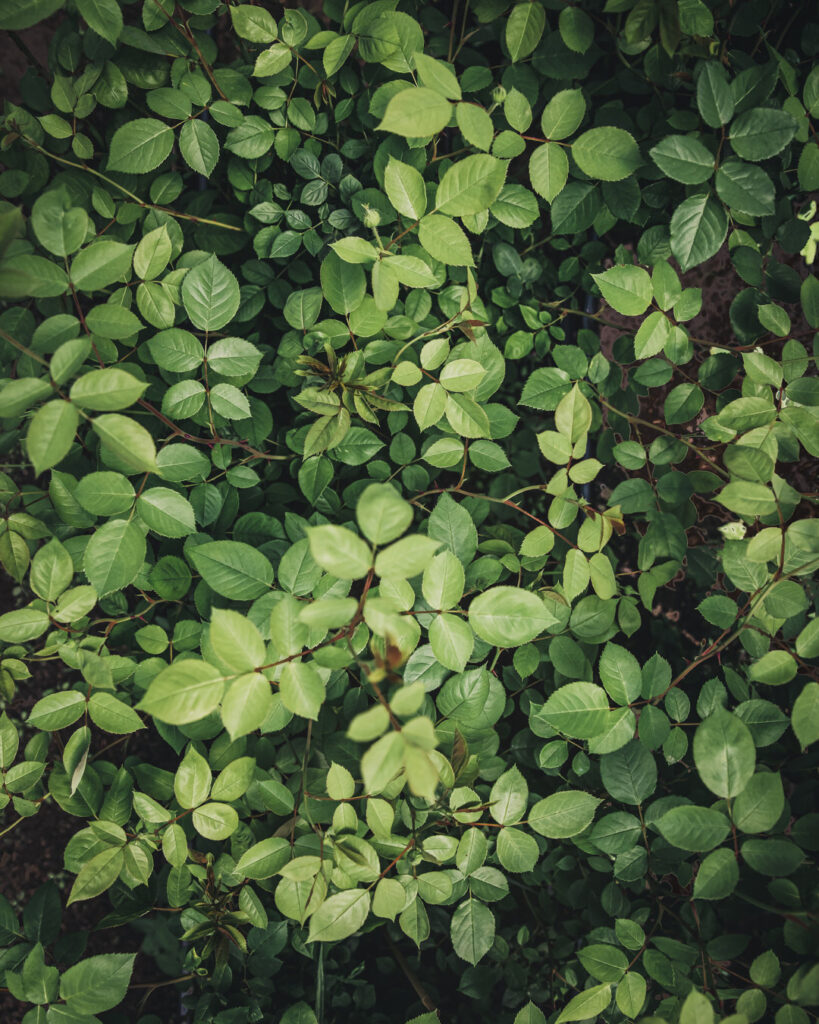
6. Weed Management
When it comes to running a flower farm, the previous few sections no doubt demonstrated that there is a lot more to it than simply growing flowers. When you’re busy running your business and marketing your flowers, weeds can quickly take over. A seasoned farmer once said that if your only weed management plan is pulling weeds by hand, you’re doing it wrong. While you certainly *can* and will be weeding by hand, it should not be your only management plan because it is not efficient.
A plan for suppressing weeds a must-have for your flower farm business. There’s no one right way, and you’ll likely employ different practices for different crops, as well as a combination of practices.
There are many weed management practices, but some of the most common are weed suppression with barriers like landscape fabric and mulch, cover crops, intensive spacing, mechanical cultivation, hand cultivation, and herbicides (though we do not use or advise this). While we’ll dive deep on weed control in a future article, here are some high-level notes.
Weed barriers reduce weeds by blocking them. One of the most common weed barriers used in the flower farming world is landscape fabric. Here is a great video on growing with landscape fabric if you’re not familiar with growing this way. We use DeWitt Sunbelt Woven Landscape fabric, which we get through our local greenhouse supplier.
Mulch is another very common practice where growers suppress weeds by covering them. Growers mulch with a variety of materials, including but not limited to cardboard, paper, leaves, grass clippings, straw, hay, wood chips, compost, and more.
Cover crops help suppress weeds by either competing with weeds during the off season or competing with weeds between in pathways and between rows.
Intensive spacing minimizes weeds by outcompeting them for light, water, and resources once plants have matured. For example, when plants are spaced closely, they create a canopy, shading out competing weeds.
There are many different types of mechanical cultivation, like tillers, tilthers, tractor implements, and flame weeders. Similarly, there are numerous hand tools like collinear hoes, stirrup hoes, wire weeders, and more.
As previously mentioned, we’ll do a deep dive on weed management, but it’s a must consider for your farm business. In the past, we’ve relied heavily on landscape fabric and mulch (and tillage, though we try to keep this to a minimum). However, I’m experimenting this season with more-precise spacing and cultivation with hand tools. Plant Profiles discuss how we manage weeds for individual crops.
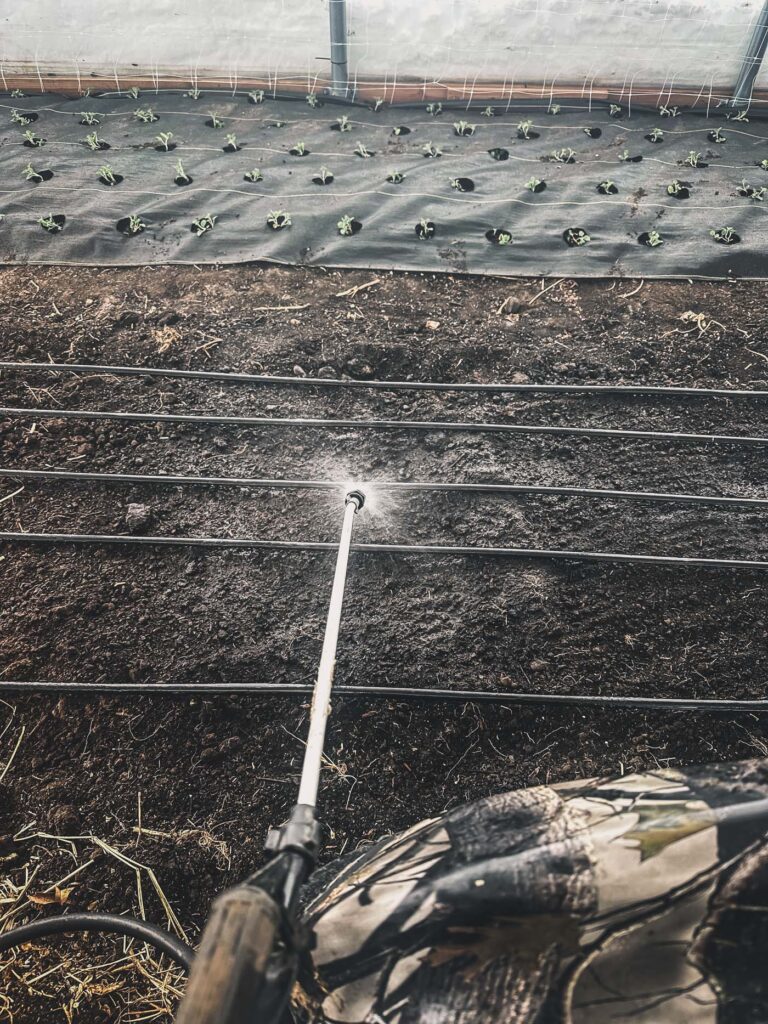
7. Irrigation
Unless you have extremely consistent rainfall, a plan for irrigation is a must. Moisture needs can vary by plant, but most flowers need adequate moisture to achieve optimum stem length. While Plant Profiles outline unique moisture needs, inadequate moisture can lead to stunted growth, shorter stems, and underdeveloped blooms.
If you’re growing more than 1/8 of an acre, watering by hand will be extremely time consuming. I know, I had to for part of our first season, as we did not have running water down in our field. At the time, I used a water tank attached to our ATV. While it was doable, it was extremely difficult and time consuming, and I don’t think I could have done it for an entire season.
Most sources recommend drip irrigation for flower farming, because it limits disease and water stains on petals. On the other hand, overhead irrigation is excellent for seedling establishment. On our farm, we use both.
Drip Irrigation is a loaded topic that deserves its own article. While we’ll dive deeper on irrigation, and irrigation needs will vary depending on your unique situation, DripWorks is a great resource and place to start researching. We now get our drip irrigation from our local greenhouse because of cost. However, prior to this, we got everything through DripWorks, which is pretty decent if you don’t have a local source.
From DripWorks, we used Aqua-Traxx Azul 15 Mil 8″ Drip Tape Rolls with matching fittings and 3/4″ Poly Tubing main line with matching fittings (and similar items through our local greenhouse). If those terms don’t make sense just yet, that’s OK, I only include it for those who want specifics. Drip tape is a bit of a rabbit hole, but the suppliers usually make it pretty easy to ensure you’re getting the right components for each part. I’ll dive deeper on this as well in upcoming posts, but it’s important to start thinking about how you’ll water your plants when you’re just starting out.
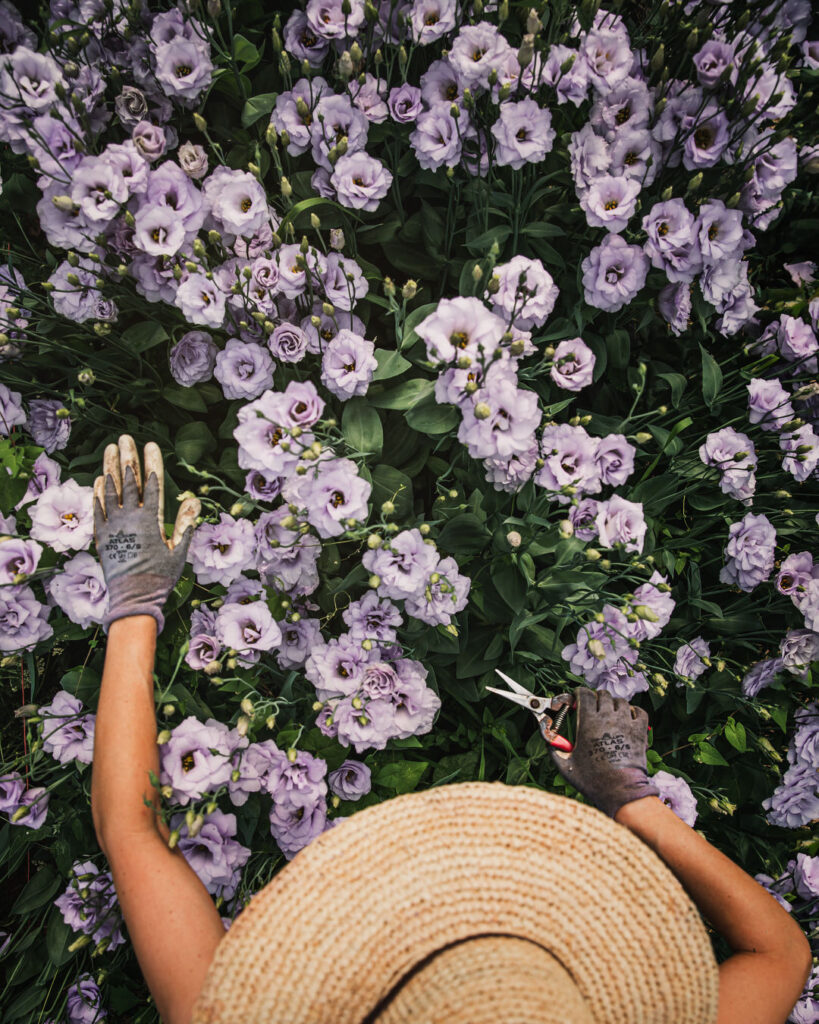
8. Harvest, Storage, & Packing Supplies
In order to sell your flowers, you need to be able to harvest, store, and package your flowers!
Harvest Supplies
Must-Have Harvest Supplies
- Snips
- Gloves
- Buckets
- A-Roo or local
- Rubber bands
- Post-Harvest Solution (article and sources here)
Also read:
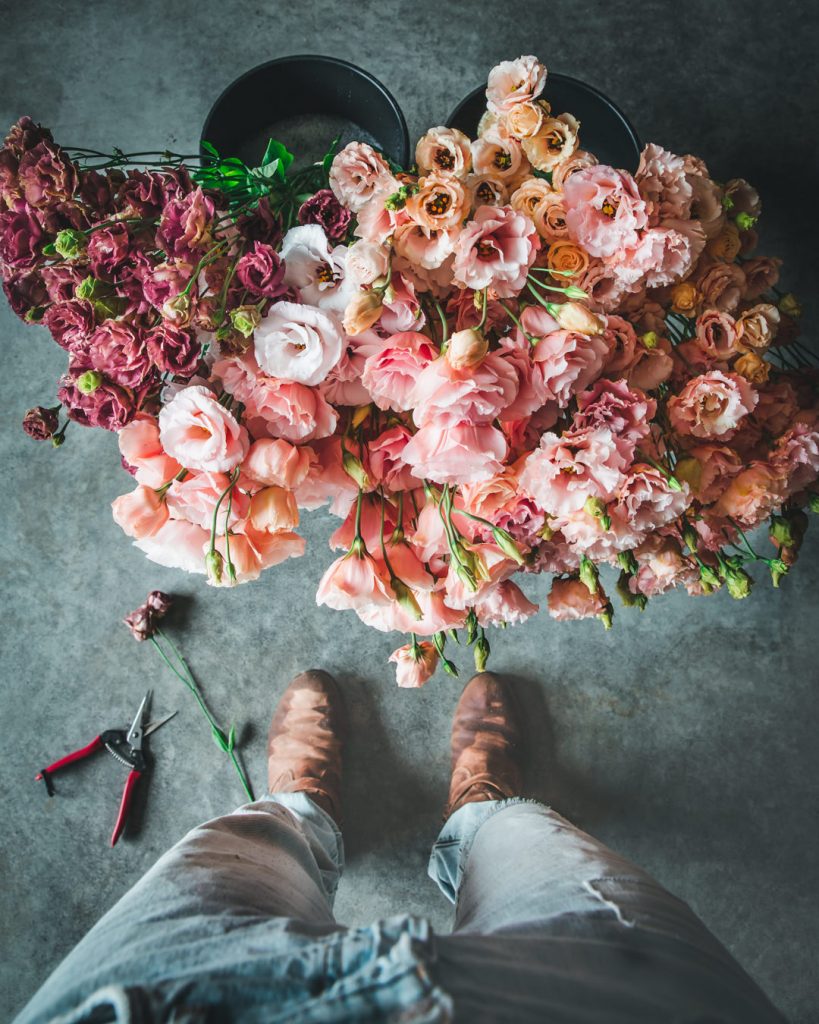
Storage
While I think you can get away without a cooler initially, if you plan to sell your flowers at scale, eventually you’ll want one if you want maximum longer-term storage time top-quality flowers. My first season, I did not have a cooler. I would harvest and haul flowers to put in the utility room in our basement (the coldest space in the house). We did not grow any spring flowers like tulips our first season. It worked for flowers that were going out that week, but it was certainly not efficient and would not work for longer storage.
The ability to sell flowers over a longer period of time means that the cooler makes up for the initial investment quite quickly. If you plan to grow tulips and peonies, a cooler is a must in my humble opinion. When those flowers come on, they must be harvested right away. Unless you have an immediate market to sell all those blooms, you want to be able to store them (you can happily store them for a few weeks to a month!).
A cooler is also really important if you want to get into weddings and events. It allows you to harvest flowers at the perfect stage and hoard them for a longer time for an event. This makes the whole process less stressful, because you know you have flowers available and ready.
A cooler also means better-quality blooms. Most flowers prefer to “rest” or condition in a cold space prior to arranging (at least 3 to 4 hours). It’s honestly amazing how some flowers that are thought to be more wilt-prone, like nicotiana or scented geranium, perk right back up after hydrating and conditioning in a cooler. Similarly, a cooler means longer vase life for your end customer, which in turn makes you a trusted source for flowers!
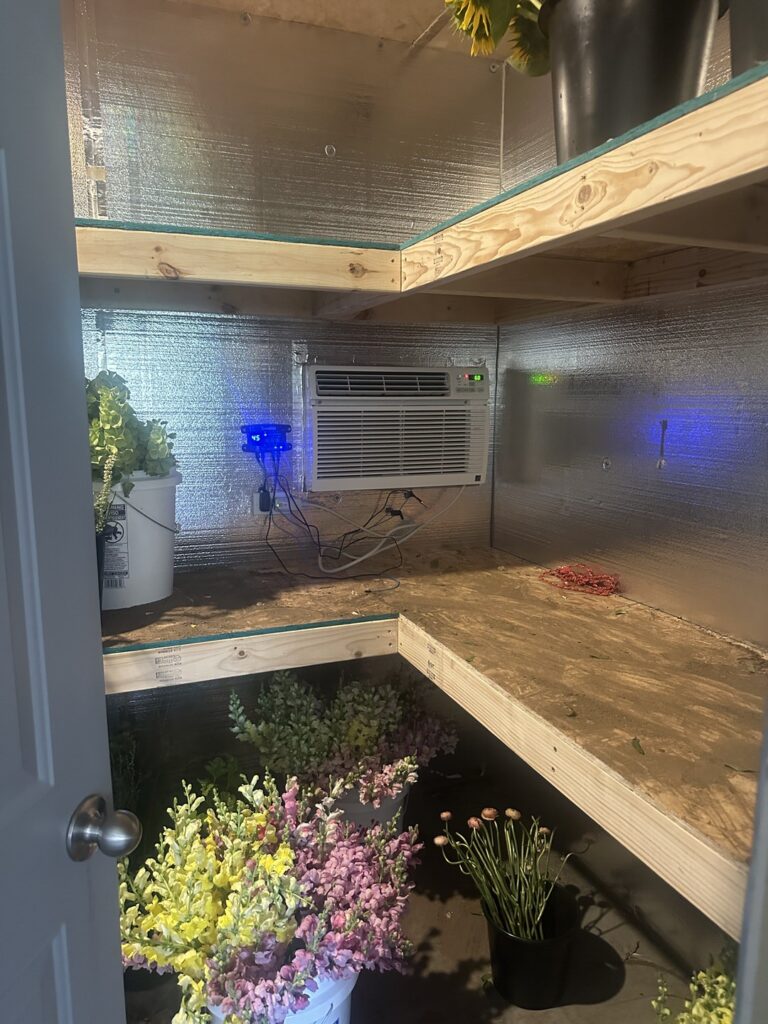
COOLBOT SYSTEM
While there are many cooler options, we are super fond of the CoolBot system for its ease of use and economical price tag. The CoolBot is a device that can transform an insulted room or trailer into an affordable walk-in cooler with a standard window air conditioner. Unlike a traditional walk-in cooler, repairs and/or replacements are much simpler (not requiring a special technician), since the CoolBot uses a regular air conditioner.
Whether you want to add a cooler to an existing structure, build a new structure, convert a trailer, or retrofit an existing cooler, StoreIt Cold (the company who created the CoolBot) has detailed instructions and information here. At first this seemed daunting to me, and although Matt is much-more handy than me, this company does a great job simplifying the process.
When we built our pole barn, Matt built a little shop area, which included a 9x8x8 cooler. I would say that we did not deviate from the CoolBot instructions with the exception that we did not insulate the floor (however, the entire shop area is extra insulated and it has not seemed to be an issue). In fact, I think the concrete floor is important for spills. We purchased this air conditioner and have not had any issues with it thus far.
P.S., if you want a coupon for $25 off a CoolBot system, use this link.
P.P.S., we also convert our cooler into a heated space in the winter for storing our dahlia tubers.
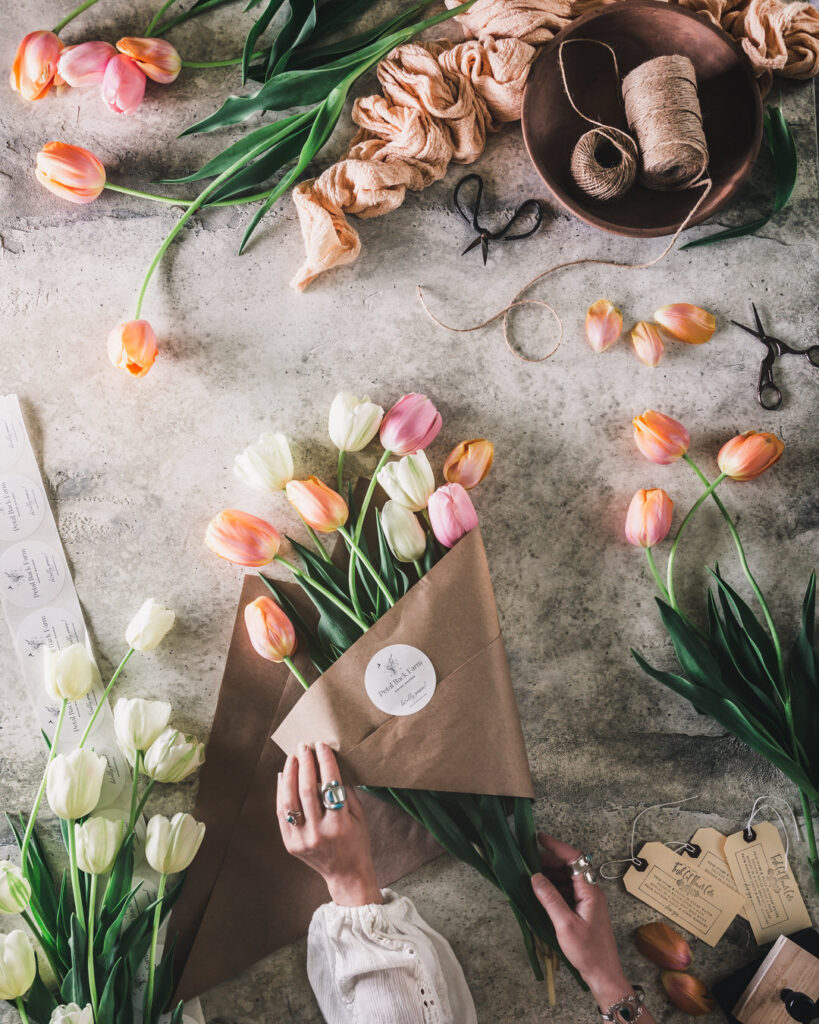
Packing Supplies
How you package your flowers will depend on your customers and sales channels, but you must be able to package them, including your branding. Nothing should leave the farm without your farm name and contact information on it. This can be as simple as a sticker with your farm name and a way for people to contact you (website, email, or phone number).
While each sales channel will have their own specific packing needs, here a few of our must-have items:
- Bouquet Wraps
- You can get the pre-made ones through A-Roo, but I find wrapping with Kraft paper extremely fast and easy (and easily adjustable for different sizes, tutorial forthcoming)
- Tissue Paper
- For XL Bouquets
- Wrapped on inside of bouquet wraps
- EcoWraps
- For bouquets that will be out of water for hours (our market bouquets we wrap so the stems can sit in bucket and drink water, but these are great for when that is not an option, like sending home flowers are flower bar pop-ups)
- Stapler
- I used to tie our market bouquets with twine, but we now use a stapler to make the process more efficient
- Ribbon
- Harvest Buckets
- For transport
- Local Greenhouse or A-Roo
- Rubber Bands
- Stickers
- I typically print my own but have recently tried noissue for cards and plan to try them for stickers
- Mason Jars
- Twine
- Cut-Flower Care Stamp
- Cut-Flower Care Tag
- Compostable Flower Food
- Every Day Vases (Laney, in both sizes, if you are unable to purchase wholesale, I’ll be offering these on our website soon)
- Seminole Delivery System
- Worth every penny, we love this thing

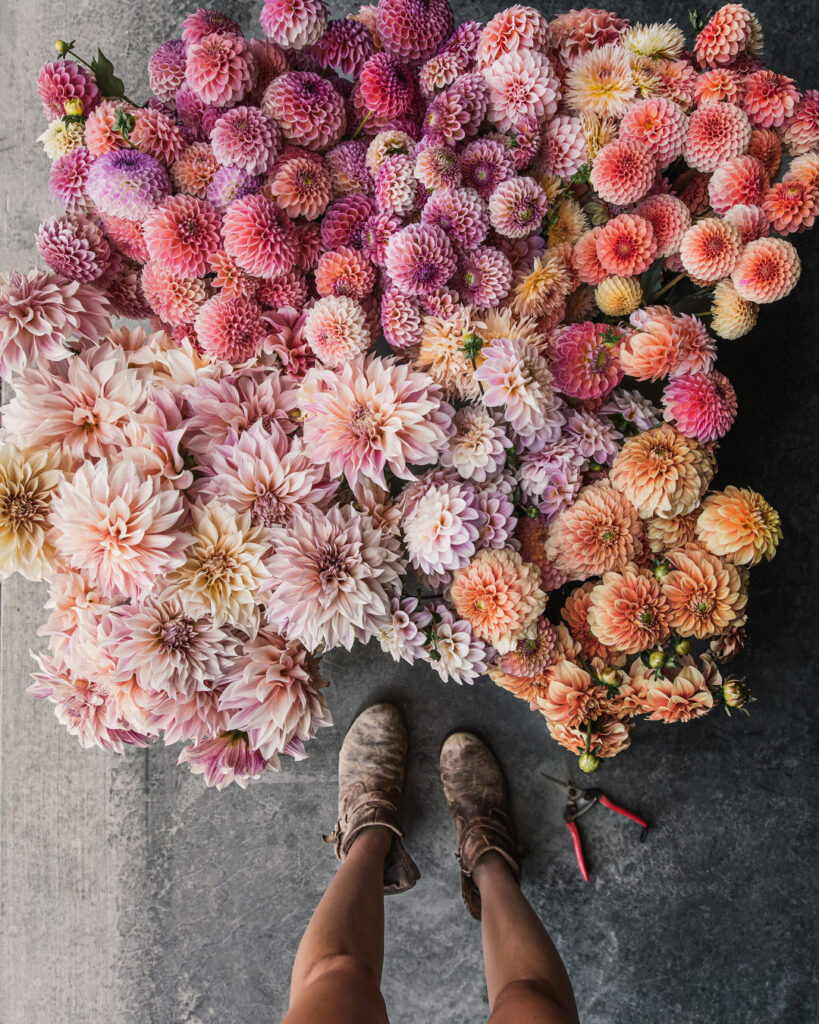
Newsletter/Website (and probably Social Media)
In my humble opinion, you need all three. Can you get away with not having them? Sure, probably, maybe, I don’t know. It depends on your goals and market, but I know that they are essential to our business, and I’ll explain why.
When you need or want something, what is the first thing you do? You look it up online. Gone are the days of the phonebook. Your website and social media are very likely your customers’ first impression of you.
And that first impression matters. According to a study conducted by Harvard, it only takes a fraction of a second for users to formulate an opinion about a website, highlighting the importance of visual appeal. Similarly, think about how you decide to follow an account on social media. A post likely caught your attention, but what do you do next? You go to their profile, scan a few words, and check out their grid to see what they are about. Usually, you make a quick decision if they are worth a follow or not.
While we’ll dive deep into the nitty gritty on these in future posts, here is how I think about each of these digital tools as one marketing ecosystem.
Digital Synergy
My newsletter, website, and social media work synergistically, but they are all not created equal in my eyes.
First, and most importantly, newsletter is king (ahem, queen?), top dog, whatever you want to call it. It’s not the most glamorous and does not get as much attention as social media and websites, but honestly: that’s all backwards. You want everything funneling into your newsletter. Social Media > Website > Newsletter. Why? You own it, it allows you to connect deeper with your audience, and it has a higher return on investment.
In terms of ROI, email marketing tends to have a significantly higher return than other channels, as it’s estimated that email generates $36 for every $1 spent—an astounding 3600% ROI. On the other hand, social media generates an estimated return of $2.80 for every $1 spent.
While newsletter is numero uno for me, all three work synergistically together. Brass Tacks: My social media should be driving people to my website should be driving people to my newsletter. Let’s look at each one.
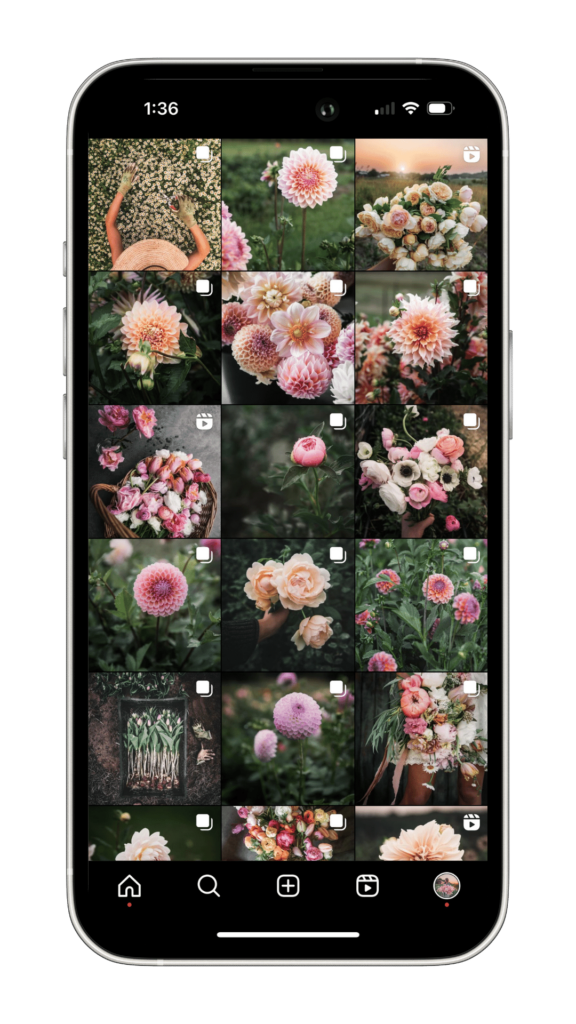
Social Media
Social Media is just what it says: Social! It’s a way to connect with other people! You’ll hear people say to “stay in your lane” or “know your audience” but I think it’s more than that. Yes, sure, you want to connect with potential customers, but social media is more about connection in general, in my eyes anyway. So yes, connect with potential customers, but also: just connect! Connect with customers, peers, industry leaders, and just . . . . HUMANS. Most people want more authenticity, so I say treat social media simply as a gateway to connecting and serving others.
Also, and this is key, think of it as your public portfolio. It doesn’t need to be curated if that’s not you, but just remember that it’s a reflection of . . . you! It’s a way for people to see what you’re all about. And while you get to determine what that is, be intentional about it, because people are viewing it like a portfolio of your work.
There are many social media platforms (Instagram, Facebook, Pinterest, Twitter, etc.). I suggest starting with one to get the hang of it. Once you do, you can add others and there are apps to help you post across platforms more efficiently.
Ultimately though, the goal is to connect with folks. Hopefully people like what they see, so they decide to hang out with you OFF the app and on your . . .
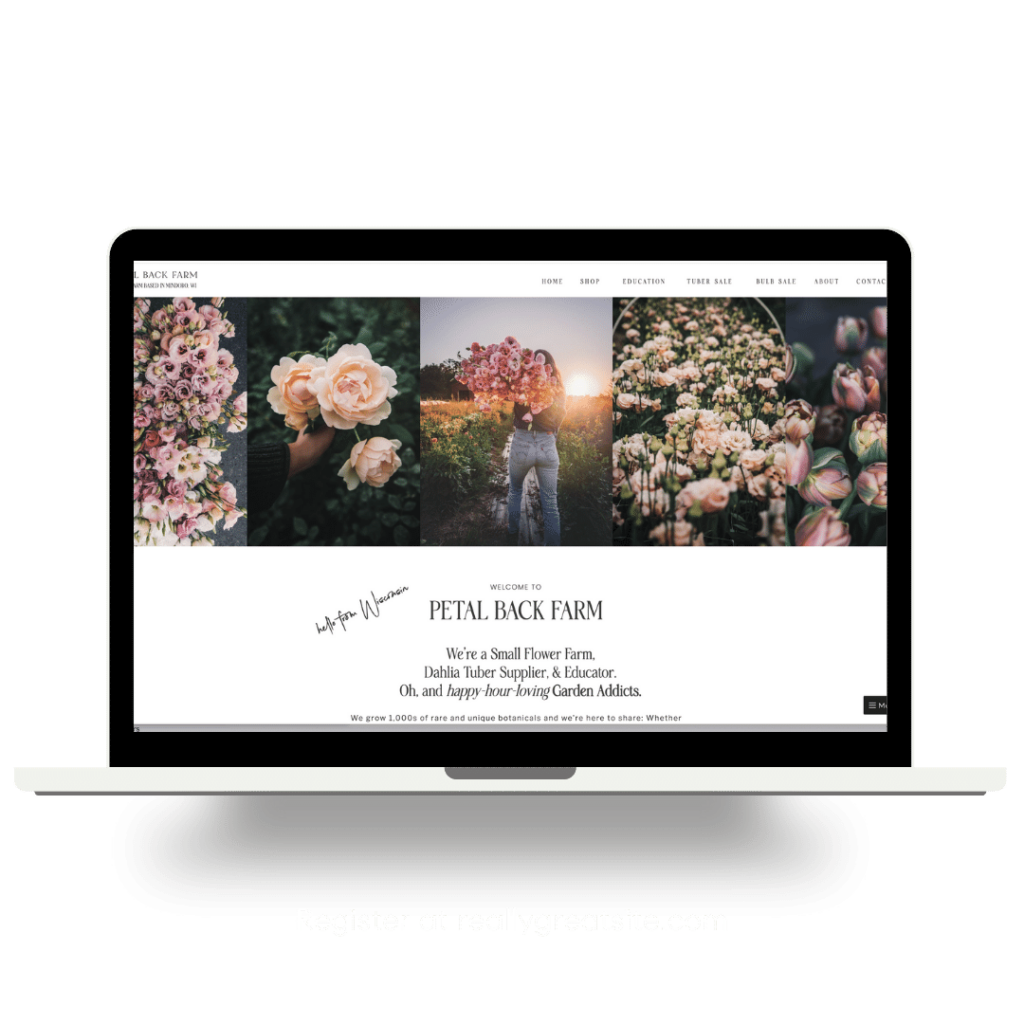
Website
Website! Your website is like your digital business card. It doesn’t need to be overly fancy or super intricate, but it should accurately reflect who you are and what you do. It creates trust by showing your potential customer that you are a legitimate business, tells them more about your story, and hopefully converts them into a newsletter subscriber.
I prefer “converts to newsletter subscriber” versus “converts a sale,” because I’d rather have an ongoing community of people (aka, newsletter subscribers) who want to connect with and support our small business versus a one-time sale from something gimmicky. You can have a heartfelt business that’s abundant and profitable while simultaneously helping people and making their lives better! I’m all about the win-win synergy of bringing positive things into the world 🙂 Heck, people buy flowers for more beauty, connection, and self-care after all!
When you’re just starting out, websites can feel daunting. However, there are many options out there to get you started. You can do something as simple as a landing page (just one page saying what you are about) and a sign up for your newsletter. You can (and should) do this BEFORE you even have any flowers to sell! This gets people into your community and you can start sharing your story. And if you feel out of your league or have no idea what you’re doing, or like what the heck even is your story? That’s OK, I even say tell people that! You’d be amazed the support you can get just by being brutally honest you. I love supporting people who are just trying to do something different and having the courage to put themselves out there.
If you’re not very tech savvy, I know a lot of folks love SquareSpace. I’ve used many platforms and templates over the years, and they all have their pros and cons. As technology changes, so do their features, so it’s important to do your own research. All that said, I have been using ShowIt for years, and it’s my favorite by far, because it’s truly drag and drop design. If you want to try it, use this link for one month free!
You can design your own website or use one of their free templates. I suggest starting with a template for learning purposes. There are also some incredibly-beautiful paid templates by super-talented designers. Before I designed my own, I purchased a template from Tonic. Not only are they stunning, these guys think of everything!
Even though I now design my own (and plan to make them available soon after requests), I stand by Tonic’s quality so much, I became an affiliate! Use this link and the code PBF15 for 15% if that interests you. Even if you don’t want a website template, sign up for Jen’s newsletter. It’s freakin’ hilarious and a great example of a really well-done newsletter IMO.
While the anatomy of a website is it’s only complex topic, the first thing to focus on is a newsletter sign up. This can be as simple as: Sign up for updates, but I like to sweeten the deal with freebies and promo codes.
OK, let’ get into numero uno:
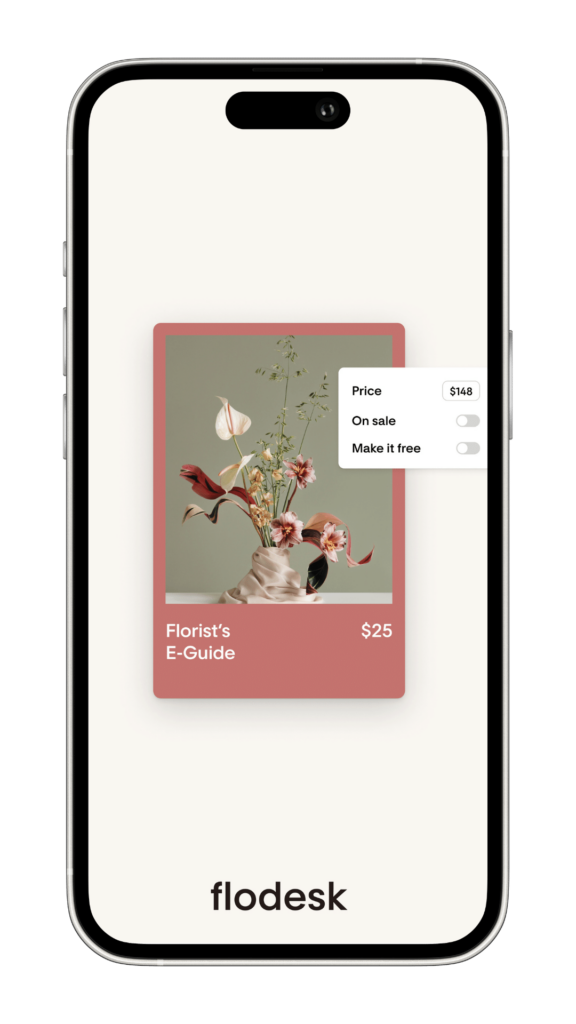
Newsletter
Depending on your website provider and newsletter service, creating a sign up on your website is usually fairly straightforward. Both providers will likely have in-depth tutorials. A popular free subscription service is Mailchimp, which I used for years. I now use Flodesk, which I love. Easy-to-use elevated designs. With Flodesk, you can even create simple landing pages if you don’t have a website yet. They are also rolling out options for online sales, meaning you could potentially get away with only this, depending on your needs. And um, you know I got another code: this link for 50% off your first year!!
When it comes to newsletters, don’t overthink it. In fact, when you’re first starting, this is a low-pressure way to start connecting with your audience. The best advice I can give is to write exactly how you talk to a close friend. And write to ONE person. They may sound counterintuitive, but when you write to everyone, you’re writing to no one.
When you write like you’re talking to a close friend, it actually sounds like YOU! It’s usually more clear, direct, and to the point, because this is how people talk in real life. It makes people feel more connected. When I started, I was insecure, and tried to use professional language I learned at my corporate job. But corporate language lacks warmth and quite frankly, it’s boring, not impressive, and sucks the life out of you. (In fact, if you’ve been in the corporate world for a long time, you know it’s actually not even how colleagues talk).
When I started talking in my own voice, people started responding. We want to do business with people we know, trust, and like. Also, when you write in your own voice, the process is usually faster! Don’t overthink it. You’ll get better as you go. Just write, share with people, see what resonates. You don’t even need to be selling anything or talking about flowers. Half the time I’m complaining about chickens in my newsletter, but guess what? Those newsletters sell flowers. My humble two cents? Instead of worrying about sales, worry about connecting.
Wrap Up
OK, my frand, that is it for my 9 Must Haves for a Flower Farm Business. Is there anything you would add? What do you want to dive deeper on?!
cLICK FOR Comments +